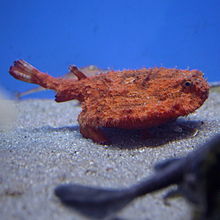Ogcocephalidae
| Ogcocephalidae | |
|---|---|

| |
| Halieutaea stellata in Takeshima Aquarium, Japan | |
| Scientific classification | |
| Domain: | Eukaryota |
| Kingdom: | Animalia |
| Phylum: | Chordata |
| Class: | Actinopterygii |
| Order: | Lophiiformes |
| Suborder: | Ogcocephaloidei Pietsch, 1984 |
| Family: | Ogcocephalidae D. S. Jordan, 1895 |
| Genera | |
|
see text | |
Ogcocephalidae is a family of anglerfish specifically adapted for a benthic lifestyle of crawling about on the seafloor. Ogcocephalid anglerfish are sometimes referred to as batfishes,[1][2] deep-sea batfishes,[3] handfishes, and seabats.[4] They are found in tropical and subtropical oceans worldwide.[2] They are mostly found at depths between 200 and 3,000 m (660 and 9,840 ft), but have been recorded as deep as 4,000 m (13,000 ft).[2][5] A few species live in much shallower coastal waters and, exceptionally, may enter river estuaries.[2]
Taxonomy[edit]
Ogcocephalidae was first proposed as a separate family, the Chaunacidae, by the American biologist David Starr Jordan in 1895.[6] Charles Tate Regan placed this family within the division Antennariformes within his suborder Lophiodea when he classified the order Pediculati, his grouping of the toadfishes and anglerfishes.[7] In 1981 Theodore Wells Pietsch III realised that the monophyly of Regan's 1912 groupings within his Lophoidea had not been confirmed. Pietsch proposed a sister relationship between the sea toads and the Ogcocephalidae, however, was unable to identify any grouping that was a sister group to both the Chaunacidae and Ogcocephalidae nor did he find any osteological characters to support or otherwise their classification within the Antennariiformes. He, tenatively, retained both groups within the Antennarioidei even although he was unable to establish the monophyly of the four families Regan classified in the Antennariiformes in 1912. In 1984 Pietsch classified the Ogcocephalidae in the monotypic suborder Ogcocephaloidei within the Lophiiformes.[8] This is the classification followed by the 5th edition of Fishes of the World.[9]
Three common genera, Ogcocephalus, Zalieutes and Halieutichthys, of batfish are closely related, each being referred to as a “sister group” of the other Each species evolved from the Eastern Pacific and Western Atlantic ocean around 56-60 million years ago.[10]
Genera[edit]
Ogcocephalidae contains the following genera:[11]
- Coelophrys Brauer, 1902
- Dibranchus Peters 1876
- Halicmetus Alcock, 1891
- Halieutaea Valenciennes, 1837
- Halieutichthys Poey, 1863
- Halieutopsis Garman, 1899
- Malthopsis Alcock, 1891
- Ogcocephalus Fischer, 1813
- Solocisquama Bradbury, 1999
- Zalieutes D. S. Jordan & Evermann, 1896
Characteristics[edit]
Ogcocephaloidei batfishes are dorsoventrally compressed fishes similar in appearance to rays, with a large circular or triangular head (box-shaped in Coelophrys), and a small tail. The largest members of the family are approximately 50 cm (20 in) in standard length. The illicium (a modified dorsal fin ray on the front of the head supporting the esca, a bulbous lure) may be retracted into an illicial cavity above the mouth. The esca is not luminous, as in most other groups of anglerfishes, but secretes a fluid, lasting approximately two minutes, thought to act as a chemical lure which attracts prey such as crabs, snails, shrimp, and small fish.[12] Analysis of their stomach contents indicates that batfishes feed on fish, crustaceans, and polychaete worms.[5]
The pelvic and anal fins of many species are stout and thick-skinned, so as to support the body off the substrate. These fins also enable batfishes to walk on the seafloor, though the irregular shape of the fins causes most batfishes to swim awkwardly.
Gallery[edit]
-
Painting of Halieutaea stellata by Kawahara Keiga, 1825
-
The longnose seabat (Malthopsis lutea)
References[edit]
- ^ Derouen, V., et al. (2015). Examining evolutionary relationships and shifts in depth preferences in batfishes (Lophiiformes: Ogcocephalidae). Molecular Phylogenetics and Evolution 84, 27-33.
- ^ a b c d Family Ogcocephalidae - Batfishes. FishBase. 2016.
- ^ Bray, D. J. 2012. Ogcocephalidae: Deep-sea Batfishes. Fishes of Australia, accessed 07 May 2016.
- ^ Ogcocephalidae. Australian Museum.
- ^ a b Bertelsen, F. & Pietsch, T.W. (1998). Paxton, J.R. & Eschmeyer, W.N. (eds.). Encyclopedia of Fishes. San Diego: Academic Press. pp. 139–140. ISBN 0-12-547665-5.
- ^ Richard van der Laan; William N. Eschmeyer & Ronald Fricke (2014). "Family-group names of recent fishes". Zootaxa. 3882 (2): 1–230. doi:10.11646/zootaxa.3882.1.1. PMID 25543675.
- ^ Regan, C.T. (1912). "The classification of the teleostean fishes of the order Pediculati". Annals and Magazine of Natural History Series. 8 & 9: 277–289.
- ^ Arnold, Rachel J. (2014). Evolutionary Relationships of the Enigmatic Anglerfishes (Teleostei: Lophiiformes): Can Nuclear DNA Provide Resolution for Conflicting Morphological and Mitochondrial Phylogenies? (PhD thesis). University of Washington.
- ^ Nelson, J.S.; Grande, T.C.; Wilson, M.V.H. (2016). Fishes of the World (5th ed.). Hoboken, NJ: John Wiley & Sons. pp. 508–518. doi:10.1002/9781119174844. ISBN 978-1-118-34233-6. LCCN 2015037522. OCLC 951899884. OL 25909650M.
- ^ Shimazaki1, et al. 2004
- ^ Eschmeyer, William N.; Fricke, Ron & van der Laan, Richard (eds.). "Genera in the family Ogcocephalidae". Catalog of Fishes. California Academy of Sciences. Retrieved 30 April 2024.
- ^ Theodore W. Pietsch (2005). "Ogcocephalidae". Tree of Life web project. Retrieved 4 April 2006.
Further reading[edit]
- Rade, C. M. (2011). Functional fin morphology of aquatic substrate-based locomotion in ogcocephalid fishes (Lophiiformes;Ogcocephalidae). Integrative and Comparative Biology., 51, E241–E241.
External links[edit]
 Media related to Ogcocephalidae at Wikimedia Commons
Media related to Ogcocephalidae at Wikimedia Commons


